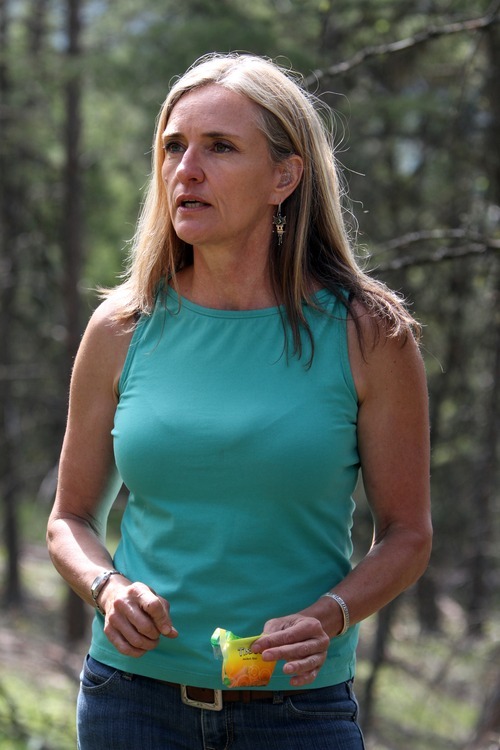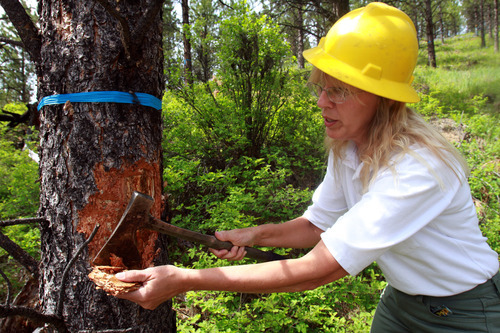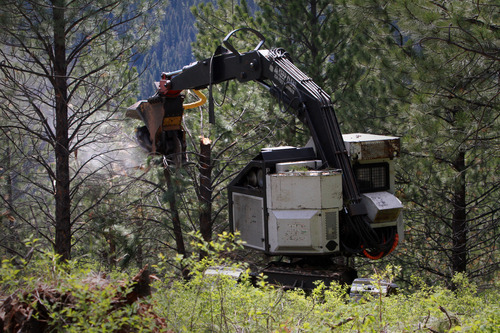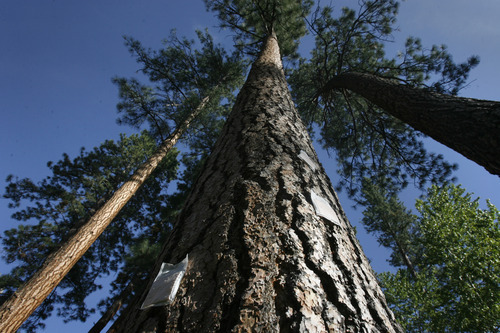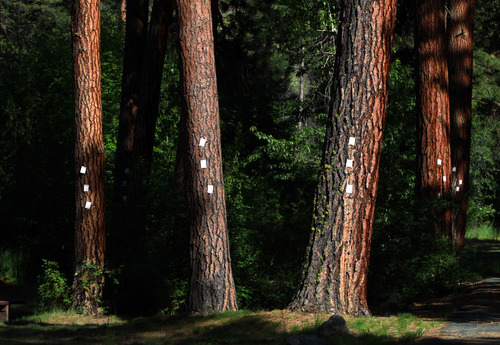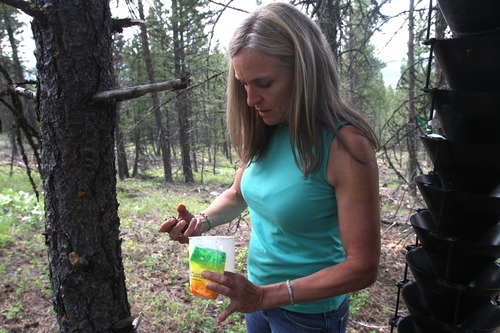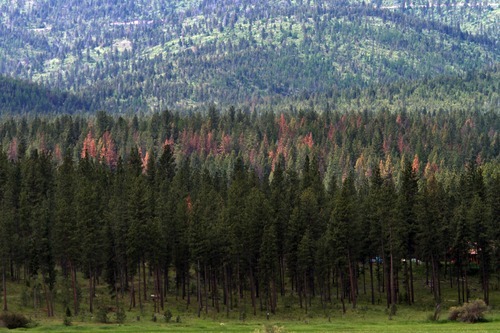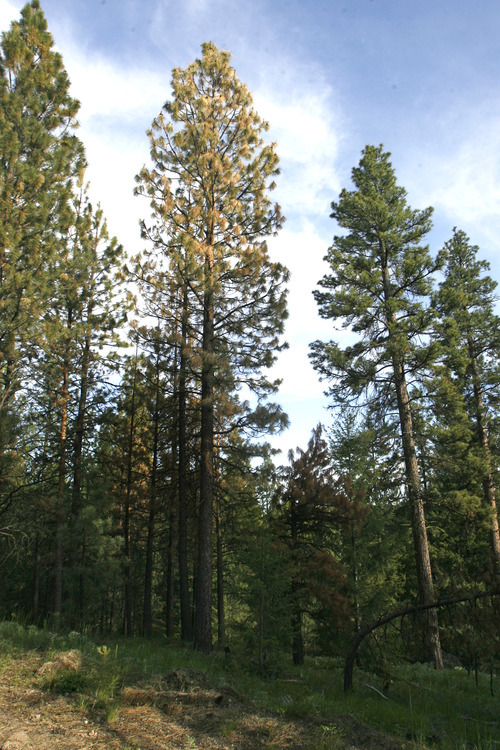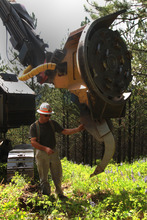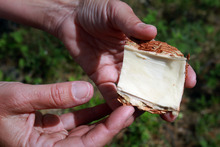This is an archived article that was published on sltrib.com in 2011, and information in the article may be outdated. It is provided only for personal research purposes and may not be reprinted.
Darby, Mont. • It's war on the Bitterroot.
Chemical war. Biological war. Scorched earth.
Having watched mountain pine beetles blitz the Continental Divide forests east of here for the past decade, leaving practically no mature pines living near the state's capital, western Montanans are primed for a fight.
"In Helena and Butte, they'll have a whole generation that won't know what [Montana] looked like," said Nancy Sturdevant, a U.S. Forest Service entomologist who is nursing the Big Sky state's wilds through the epidemic.
It's an extreme example of a phenomenon that has consumed more than 40 million acres of the West's forests since 1997. Researchers say warming winters have aided the beetles' survival beyond historic outbreak numbers. Average winter lows in Montana's forested ranges have climbed 4 to 6 degrees Fahrenheit in the past half-century.
But there's also widespread fear that the government worsened the mess by letting the woods grow overcrowded.
Now, with Montana's battle shifted to the Bitterroot National Forest, federal authorities aren't holding fire. The people of Missoula — a nearby college town usually inclined to let nature do its thing — aren't giving them much choice after watching the eastern carnage.
A 2000 fire that scorched hillsides near Darby was a further call to action, Sturdevant believes, because it showed Montanans that flames would take what beetles didn't. Loaded with fuels, the forest burned intensely along Highway 93; nothing has grown back in the seared soil.
Former Mayor Daniel Kemmis, an author and public-lands consultant known for illuminating his city's environmental ethos, said Missoulians are ready to support tree thinning. Foresters have rebuilt trust since the clear-cutting 1980s timber wars, he said, and the urgency is obvious.
"You really can't drive or fly around and see the extent of beetle kill and not be worried," Kemmis said.
When Bitterroot foresters hold public meetings proposing the next steps, residents urge them to do more. So crews are hosing Carbaryl, a chemical insecticide, up and down tree trunks in accessible recreation zones. They're tacking anti-beetle pheromone pouches on prized shade trees in campgrounds. Most of all, they're hacking trees before the beetles can.
Stripping 40 percent of the ponderosa pines on the overcrowded slopes of these purple mountains gives the rest a fighting chance, Sturdevant said. The trees that are left have more resources to stay healthy.
"We greatly reduce [beetle kill] but can't eliminate it," Sturdevant said. "We're not God."
Leave the trees growing thick, though, and the beetles show no mercy.
"You wouldn't have a stand left to start with," Sturdevant said, showing off a recently thinned hillside of hearty ponderosas in a drainage called Swift Creek. "Here, you're leaving genetically superior trees."
—
Logging's return • Farther up the mountain, where the government is thinning more trees, a treaded tractor, called a "masticator," climbed a steep slope, swinging a spinning grinder and chewing trees to the ground.
The operator guided the long grinder arm first down the side, stripping away parts beetles might find appealing even in a toppled tree. Then he raised it for the final pass and mowed the remaining wood into chips in seconds.
"It's neat to be back," said logging contractor Dyrk Krueger, a third-generation Montana woodsman whose dad once logged this area, "but it's scary to look at what's happened on the Bitterroot."
Now there's not much commercial logging to go around, and most of his time is spent restoring forest health on private lands. The Darby lumber mill is closed, as is the Smurfit-Stone paperboard factory that handled100 truckloads a day at Frenchtown until last year. Trucking to Northwest mills is too costly.
If the mills were still around, Krueger said, it might be easier to fight the insects. Any market for small sawlogs would offset the costs.
Still, in a region where few loggers remain, it's the beetles that now cover his paycheck. Or, more directly, it's the Rocky Mountain Elk Foundation. The Missoula-based conservation group wanted to battle beetles and to open space for deer, elk and other game to thrive. It's administering the work under a cost-sharing deal with the Forest Service.
The Elk Foundation's goal is to restore a natural, "parklike" savanna forest, which has clearings of grass and shrubs to benefit wildlife, said Dale Kerkvliet, the group's habitat-stewardship director.
The Forest Service estimates that every tree invaded by beetles this year will spell 14 more dead on the Bitterrootnext year. That's actually a forgiving explosion compared with the Continental Divide forests during their onslaught, when Butte saw the ratios between 2007 and 2009 accelerate from 1:12 to 1:20.
"We can still do things here," Sturdevant said. "We can still protect trees. In a lot of places, it's too late."
Two problems.
First, there aren't enough dollars or people to take on the beetles everywhere, so the Forest Service is choosing its fights — mostly picking places where lots of people expect to see green trees. The agency has about a $1 billion budget to promote forest health. That's a tiny fraction of what it would cost to alter 80 million Western acres that U.S. officials consider at risk, where costs range from $300 to $2,000 an acre.
Second, the beetles are changing tactics.
—
"Kind of freaked out" •Across Montana, mountain pine beetles usually prefer spindly lodgepole pine to the fatter ponderosa. The reason is self-preservation; the ponderosa is far better at killing beetles. Would you rather strangle a grouse or a bison for your meal?
Where beetles have tried an assault and failed, a ponderosa's trunk at chest level shows gooey, pinkish gum-ball-size globs that killed the invaders.
"The beetles have a pretty dangerous lifestyle," said University of Montana entomologist Diana Six. Yet, with a few hundred or a thousand attackers, depending on the tree's health, they are proving they can beat the big guys.
At the university's Lubrecht Experimental Forest east of Missoula, Six hacked into a ponderosa's bark with a hatchet in early July, wedging off a slab full of tunneled beetle "galleries" with squirming white larvae still maturing to the hard-shelled black stage when they fly.
The beetles are flinging themselves at ponderosas as never seen before. Two likely explanations exist.
One is that parts of Montana don't have a lot of lodgepole left on which to prey. The beetles "just munched their way out of house and home," Sturdevant said. The other is weather-related and potentially more frightening if the past decade's weather points to future trends.
Drought has weakened the trees' defenses. Couple the lack of moisture with a long period of inactivity by loggers or thinning crews, Sturdevant said, and the ponderosas are in deadly competition.
She is not ready to call that climate change because yearslong droughts prompting beetle kills are part of the natural cycle. "When does that turn into climate?"
Others believe these conditions represent the new norm because the region's frost-free growing season has added two weeks in a generation or so without increasing average moisture. The longer the annual competition lasts, the greater the stress.
Beetles have gotten into ponderosa before, Six said, but not longer than a few years.
"This time they're not pooping out," she said. "That's what's got a lot of us kind of freaked out."
—
Dust Bowl times 10 •The 1930s Dust Bowl was widely considered a plague in the Rockies, when beetles exploded and killed trees. Likewise, a handful of dry years in the 1970s denuded mountains. But Six believes this is the worst outbreak ever — perhaps 10 times the Dust Bowl's death count.
It's impossible to compare today's killing zones to the Depression era in direct terms, because foresters now fly airplanes with satellite-guided charting tools instead of drawing crude maps from personal observations made on a mule's back. But scientists, including at the Forest Service's Rocky Mountain Research Station in Utah, agree there has been nothing like this in recorded history.
Tree-ring analysis dating to the 1800s fails to show any signs of a greater collapse. But Barbara Bentz, an entomologist at the station, is working with other researchers studying ancient lake deposits to gauge whether prehistoric disturbances were on this level.
"Climate has changed in the past," Bentz said. "Certainly what's happening now is big, but I don't want to say it hasn't happened before."
Six calls the beetles "my organism" and, like other scientists, she speaks in endearing tones when discussing the insects. They're native to the forest, after all, and through time they have a role in opening patches for shade-intolerant shrubs and seedlings.
But she believes nature is out of whack. The outbreak continues to grow despite two wet La Niña years, which might ordinarily break the cycle. A dry winter this year would help the attack mushroom further.
On the Bitterroot, foresters are trying to get ahead of the damage but only in places that are practical. One is Lake Como, a blue-water alpine beauty south of Missoula that draws 100,000 visitors a year.
On a ridge above the lake, where Forest Service founder Gifford Pinchot personally targeted trees for the region's largest timber sale in 1906, a commercial logging crew thinned 65 acres last year. Those trees had come back as a monolith, in contrast to what had been a blotchy, fire-thinned forest during the previous two centuries.
Now, the thinned area is chock-full of frosty-blue lupine cones and dispersed trees awaiting their fight with beetles. Standing in hot daylight, Sturdevant said the openings are their own repellent. Cool moisture on the breeze helps beetles communicate by pheromones.
But that was the easy part — 65 acres by a good dirt road. Bitterroot officials want to treat 1,500 acres around the lake, and that could take years.
There aren't enough forest employees to judge environmental impacts, area silviculturist Cheri Hartless said. "There's a lot of people that [must] walk this ground to make sure everything is kosher," she said. "And then, if there's no [timber] buyer, it won't happen anyway."
At the Lake Como Campground, crews have soaked great ponderosas with Carbaryl. At another campground, too close to the East Fork of the Bitterroot for spraying, they have stapled two pheromone patches apiece to the shady north sides of trees every 40 feet. The shade keeps them from drying out, and the spacing ensures full coverage of the scent that tells beetles to stay away.
It costs the government $7 a tree to buy the pouches in bulk, and that is impractical for the broader forest. But crews are buying time for special places in case a cooler cycle returns to slow the beetles.
For now, it's all anyone can do.


